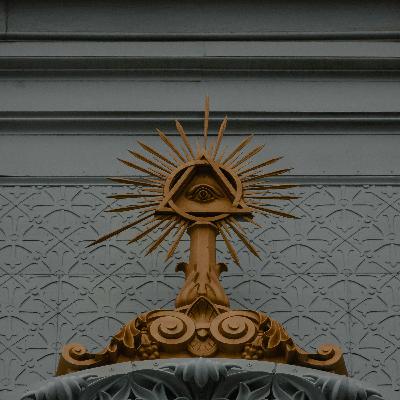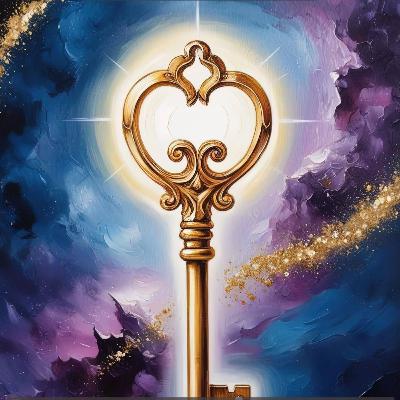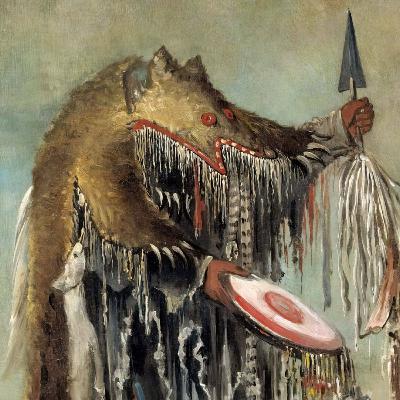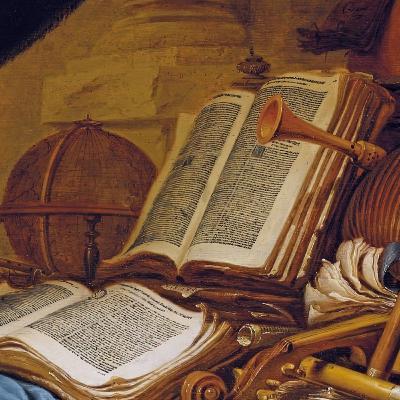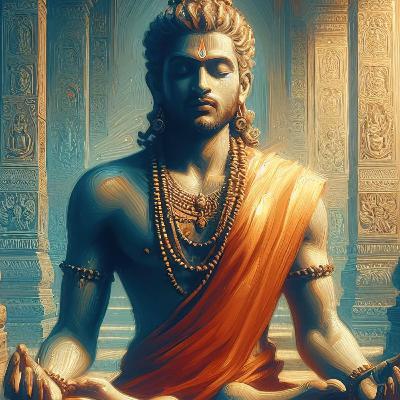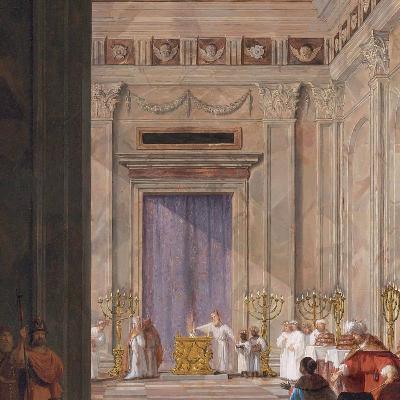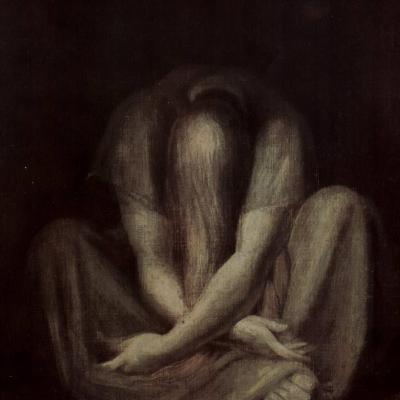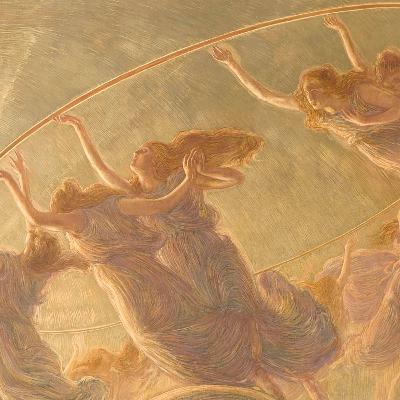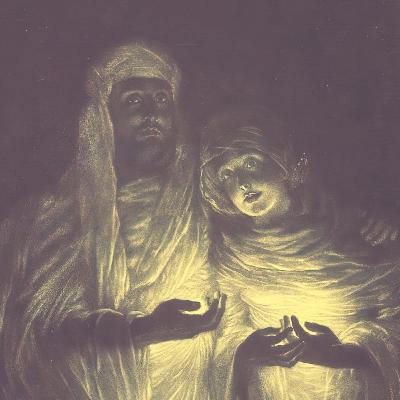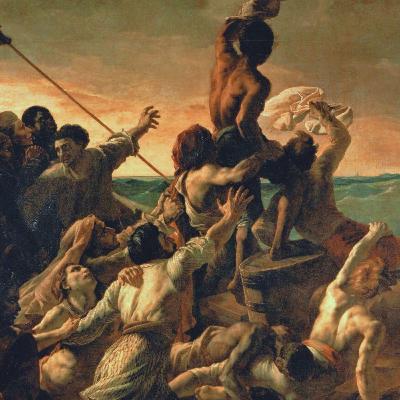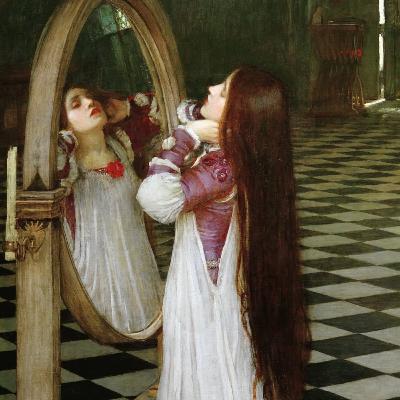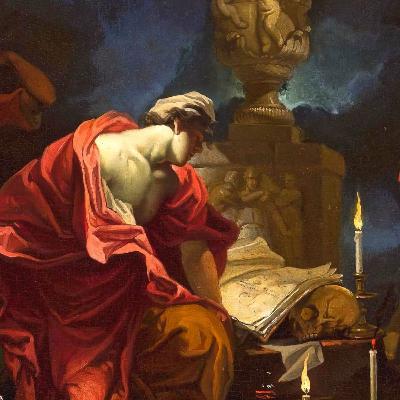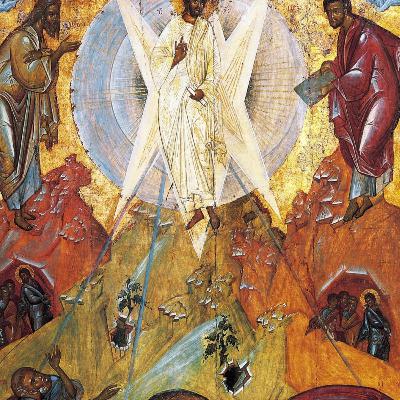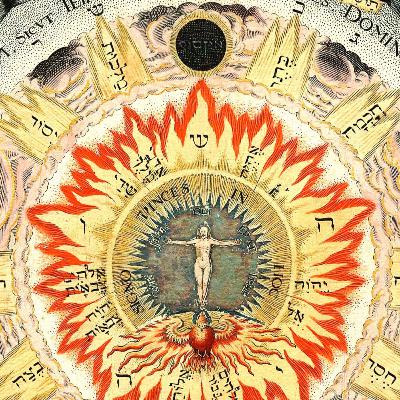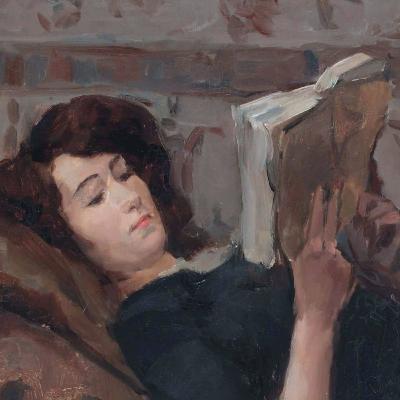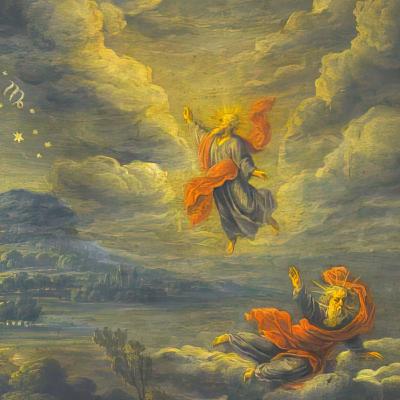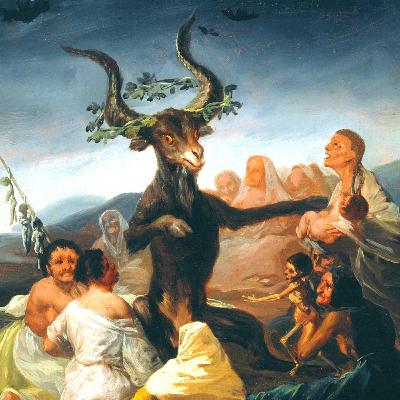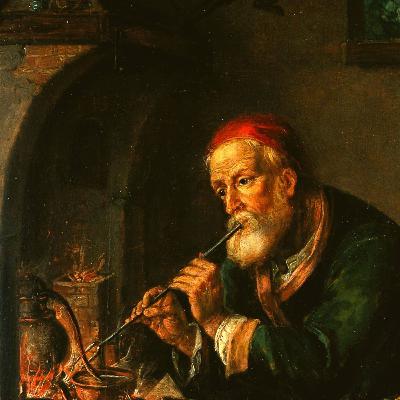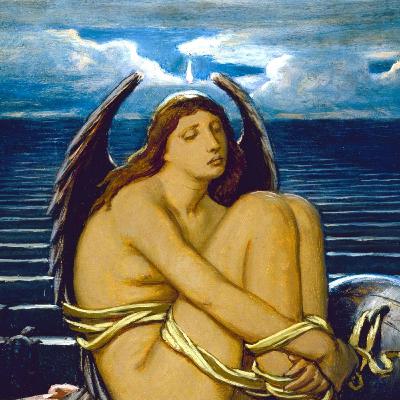Discover Occult Archives
Occult Archives

Occult Archives
Author: Falcon Millenium
Subscribed: 10Played: 160Subscribe
Share
© Falcon Millenium
Description
Throughout history certain books have been banned cursed or locked away for being too dangerous. From mystical grimoires and occult manuscripts to lost religious texts and forbidden knowledge these books hold secrets that were never meant to be uncovered. Join me as we explore the dark mysterious and often terrifying world of forbidden literature, uncovering their history the myths surrounding them and the real reasons why they were hidden from the world. Welcome to Occult Archives where we turn the pages of history’s most feared books.
276 Episodes
Reverse
The Voice of the Silence by Helena Petrovna Blavatsky is a mystical gem from the heart of the occult traditions of Tibet and India, translated from ancient texts known only to initiated mystics of the East. First published in 1889 and drawn from the legendary Book of the Golden Precepts, this text is a manual for spiritual initiation, intended not for casual readers but for seekers on the razor’s edge of spiritual transformation.Composed of three profound “Fragments”—The Voice of the Silence, The Two Paths, and The Seven Portals—the work outlines the hidden journey of the soul through ascension, renunciation, and sacred realization. Each passage drips with symbolism and metaphysical intensity, designed to awaken the inner hearing—the "soundless sound" or Nāda—that whispers to those ready to abandon illusion and walk the occult path of the Adept.🔮 Mystic Teachings from an Unknown Brotherhood: The original teachings, passed down through cryptic symbolism and ideograms in the sacerdotal Senzar language, are presented as a direct transmission from hidden Himalayan adepts.🧘 The Esoteric Path of the Bodhisattva: Blavatsky presents the two spiritual paths—the one leading to personal Nirvana and the other toward compassionate sacrifice, choosing to remain and guide others.🗝️ The Seven Portals of Initiation: These are inner gates the disciple must pass through—virtues, disciplines, and revelations that test the soul on its ascent from illusion to truth.🧠 The Slayer of the Real: “The mind is the slayer of the real,” says the text, urging the seeker to kill the illusory self, transcend sense-perception, and awaken to Sat (truth).🌌 The Doctrine of Inner Sound: The soul must attune to the inner voice—Nāda, the metaphysical frequency of the Higher Self—to achieve the wisdom of the Great Silence.This is not a book of doctrine—it is a coded map for self-initiation, steeped in metaphors drawn from Vedic scriptures, Upanishads, Buddhist Mahayana tradition, and Theosophical synthesis.Blavatsky's Voice of the Silence was revered by spiritual teachers like Annie Besant and Krishnamurti, and even recommended by the 14th Dalai Lama. But it remains largely restricted, misunderstood, and hidden to the profane world—its true meaning reserved for those who dare to walk “the steep Path of Woe” toward divine unity.What You'll Discover Inside:
The Key to Theosophy is Helena P. Blavatsky’s definitive guide to understanding the esoteric doctrine that lies beneath all great religions, mystery schools, and occult sciences. Written in the form of a powerful question-and-answer dialogue between a seeker and a Theosophist, this book reveals the true purpose, inner teachings, and initiatory structure of the Theosophical Society and the Wisdom-Religion it represents.Published in 1889, this work serves not just as an introduction, but as a forbidden index to the secret doctrine—a handbook of divine science once guarded by the initiated of Egypt, India, Persia, Greece, and Tibet. Blavatsky exposes what religions once concealed: the esoteric laws governing reincarnation, karma, the post-mortem states of consciousness, the origins of man, and the mysterious hierarchy of Masters and Mahatmas who still guard this sacred knowledge.📜 The Ancient Roots of Theosophy: From Ammonius Saccas and the Alexandrian Neoplatonists to Eastern Yogis, the book reveals Theosophy as the one eternal tradition behind all mysticism and metaphysics.🧠 Occult Psychology: Explore the sevenfold nature of man—physical, astral, mental, spiritual—and how consciousness evolves through these planes over lifetimes.🔄 Rebirth and Karma: Understand reincarnation not as belief, but as cosmic law, intertwined with karma—the divine justice that shapes our fates and futures.🪶 The Doctrine of the Mahatmas: Who are the “Masters of Wisdom”? Blavatsky lifts the veil on these hidden adepts, agents of spiritual evolution working silently across ages.✨ Theosophy vs. Religion: Rejecting blind faith and dogma, Theosophy offers direct spiritual knowledge through discipline, intuition, and occult study.🛡️ Esoteric vs. Exoteric: Learn why ancient traditions always hid their truths behind symbols, allegories, and initiatory rites—and how modern Theosophy continues this sacred strategy.Blavatsky emphasizes that Theosophy is not a new religion, but the “Wisdom-Religion” of all ages, passed in fragments through every culture, preserved in secret societies, mystery temples, and the whispered teachings of enlightened seers.Whether you're a seeker of truth, a student of comparative religion, or a curious explorer of hidden knowledge, The Key to Theosophy is a spiritual compass—one that leads beyond theology, beyond science, and into the forbidden territory of inner gnosis and divine evolution.Core Insights Unlocked Within:
In Shaman, Saiva and Sufi, R.O. Winstedt offers a scholarly yet profoundly evocative exploration of the mystical systems of the Malay Peninsula, tracing how ancient animism, Hindu esotericism, and Islamic mysticism intersect and collide. First published in 1925, this work remains one of the most insightful, comprehensive accounts of Southeast Asian spiritual traditions, and how they have been preserved, transformed, or obscured across centuries of religious conquest and colonial disruption.This book reveals a forbidden and complex spiritual legacy, one built on a vast spectrum of belief systems:Indigenous Shamanism: Rituals of the Jakun and Sakai tribes, jungle-tribes that summoned forest spirits, ancestral ghosts, and nature deities for healing and divination. Winstedt describes their trance ceremonies, animal familiars, and cosmologies in vivid ethnographic detail.Hindu (Saiva) Influence: Tracing the transmission of Indian magic, gods, and metaphysics into Malay culture, particularly the dominance of Siva (Batara Guru) and Sri, the goddess of fertility. Even after Islam’s arrival, deities like Hanuman and Krishna are preserved in veiled forms within charms and rituals.Islamic Mysticism (Sufism): Despite surface-level orthodoxy, the Malay-Muslim world absorbed deep mystical undercurrents, leading to powerful syncretic systems where jinn, saints, and saints' tombs hold protective and miraculous significance.Winstedt exposes how the magician and mystic often exist in the same person, how rites of rice-field fertility parallel Hindu ceremonies, and how ghosts of royal ancestors or dead sorcerers are still revered or feared in local communities.The Malay Magician: A master of charms, herbs, incantations, and spirit possession—part healer, part sorcerer, part shaman.The Soul of Things: A deep reflection on Malay animism, where rivers, trees, and stones possess life and consciousness.The Shaman’s Sacrifice & Séance: Firsthand accounts of magical rites, spirit-summoning, and blood-offering to win favor from unseen forces.The Sufi’s Arrival: Islam did not erase indigenous spirituality—it reabsorbed it, giving rise to a spiritual mosaic where ritual magic, ancestor veneration, and saint worship co-exist.With linguistic depth, historical grounding, and anthropological precision, Winstedt reveals the survival of hidden knowledge under the mask of orthodoxy. He documents spiritual rites too often dismissed as superstition, uncovering their roots in Hindu cosmology, pre-Islamic animism, and Sufi mysticism.This book is essential for anyone seeking to understand:The hidden layers of Southeast Asian spiritual historyHow magic, religion, and politics intertwineThe way colonialism and modernity threaten oral traditions and ancestral ritesShaman, Saiva and Sufi is a portal into a world where forbidden rituals, ancient gods, and mystical Islam form a continuous, living tradition—one not found in textbooks but in whispered incantations, sacred graveyards, and trance dances of the deep forest.Key Chapters Dive Into:
Secrets of Black Arts is a chilling anthology of real accounts, folklore, and theological speculation, compiling centuries of dark wisdom, occult phenomena, and the terrifying history of humankind’s flirtation with the Devil. Written anonymously and styled in a dramatic, almost sermon-like tone, this text plunges readers into the deep end of forbidden knowledge, tracing humanity’s darkest fears—witchcraft, necromancy, prophecy, ghostly visitations, and pacts made with infernal beings.Across its chapters, this work outlines:The Devil’s Legacy to Mortals: A philosophical and theological exploration of the Devil’s role in history and religious belief, positioning him as both a singular and collective force of corruption.Black Magic and Witchcraft: Detailed cases of historical witch trials, sorcery, and the torment of those accused, from the Witch-Finder General Matthew Hopkins to bizarre rituals of wax dolls, evil eyes, and death by supernatural curses.Prophecies, Dreams, and Apparitions: Striking accounts of dreams foretelling disasters, phantoms of the living, and the mysterious power of intuition and foresight—suggesting a thin veil between the natural and supernatural realms.Herbal Lore and the Elixir of Life: Mysterious recipes, folk remedies, and references to alchemical potions with alleged power to heal, prolong life, or even bestow immortality.The Divining Rod and Second Sight: Investigations into psychic abilities and dowsing—framed not merely as peasant superstition, but as occult faculties feared and suppressed by religious authorities.The Salem Witch Trials and Other Historical Horrors: A sobering reminder of the dangers of hysteria, mass delusion, and the manipulation of fear for social control.The book is drenched in references to Biblical condemnations of witchcraft (Exodus, Deuteronomy, Galatians), asserting that to deny the existence of such evil is to ignore both Scripture and reason. It cites sources like Blackstone’s Commentaries and sermons by early theologians to legitimize its claims. Witches, demons, sorcerers, and familiar spirits are not dismissed as myth—they are described as real, dangerous, and often bound by blood contracts with infernal powers.This is not merely a folkloric curiosity; it is a warning, penned at a time when belief in the supernatural was not optional—it was a societal norm. The Devil was not metaphorical; he was active in the world, influencing minds, destroying lives, and expanding his infernal empire through temptation, deceit, and secret rites.The book offers a fascinating historical insight into:The psychology of fear and collective delusionThe persecutory zeal of religious institutionsThe occult legacy that still haunts corners of modern beliefFor students of forbidden lore, conspiracy, or the occult tradition, Secrets of Black Arts is a rare and unsettling artifact. It captures a time when shadows were alive with meaning and the Devil’s whisper was always closer than expected.
In Fourteen Lessons in Yogi Philosophy and Oriental Occultism, William Walker Atkinson—writing under the mystical pseudonym Yogi Ramacharaka—offers a powerful, systematized exploration of Eastern metaphysics, spiritual science, and the secret mechanics of human consciousness. First published in 1904, this book is not just a guide—it's a curriculum for spiritual awakening, presented with clarity, warmth, and hidden fire.Drawing from Indian yogic traditions, Theosophy, and Hermetic philosophy, Atkinson introduces a Western audience to the forbidden knowledge of the soul, teaching how to develop powers long dismissed as supernatural, but which are—in truth—natural faculties of the awakened self.The Sevenfold Nature of Man: A full breakdown of the human being as spirit, soul, mind, energy, and body—each plane governed by its own laws and powers.Prana and Vital Force: Learn to absorb and manipulate the life energy that animates all forms; the key to healing, empowerment, and telepathic transmission.Thought Dynamics and Mental Alchemy: Master the subtle laws that govern thought, influence, and reality. The universe bends to mental vibration.The Human Aura and Magnetic Fields: Unlock your radiant energy body—learn to sense, read, and project auric forces.Telepathy, Clairvoyance, and Astral Projection: These are not fantasies—they are techniques to expand your awareness beyond the physical plane.Occult Healing and Mental Influence: Discover the blueprint of spiritual therapeutics and how energy and intention can alter health and fate.Karma, Reincarnation, and Spiritual Evolution: Understand the true mechanics of destiny, soul memory, and the upward journey through lifetimes.The Yogi Path of Attainment: A direct path of discipline, will, and awakening toward cosmic consciousness.Written in a conversational yet authoritative tone, Atkinson does not offer superstition. He offers a science of the unseen—a step-by-step revelation of truths once locked within the temples of India, Egypt, and Atlantis.This book is perfect for those who seek:To understand the secret powers of thought and consciousnessTo study authentic Eastern metaphysics without dogmaTo develop psychic faculties and spiritual perceptionA practical foundation in yogic mysticism, free from cultural distortionFourteen Lessons is not a religion—it is an ancient science made accessible to the modern seeker. Each chapter is a ritual of awakening, designed to reorient the student’s perception and to invoke the eternal truth: You are not your body—you are spirit incarnate.🕉️ Core Lessons and Teachings Include:
The Lost Keys of Masonry by Manly P. Hall is one of the most profound esoteric expositions of Freemasonry ever written—composed not by a formally initiated Mason, but by a mystic, philosopher, and spiritual teacher who penetrated the veil of the forbidden, symbolic, and spiritual origins of the Craft. First published in 1923 when Hall was just 22, this work has since become a cornerstone of occult Freemasonic literature, offering a metaphysical interpretation of Masonry's deepest truths.Rather than focusing on outer rituals or historical records, Hall ventures into the inner sanctum—the soul of Masonry—and delivers a powerful vision of a universal brotherhood whose true foundation lies not in temples of stone, but in the secret architecture of consciousness and divine purpose.The Candidate, Entered Apprentice, Fellow Craft, and Master Mason: Each stage of initiation is a step in the sacred alchemy of the soul. These are not titles—they are states of being on the path to enlightenment.The Lost Word: A spiritual mystery sought across lifetimes. Hall reveals that this Word is not external but lies dormant within the seeker, waiting to be spoken through realization.Symbolism of Solomon’s Temple: More than an allegory—it's the metaphysical blueprint of the perfected human being, built through inner transformation and divine labor.Atlantean Origins & Mystery Schools: Hall boldly suggests that Masonry is the last surviving vessel of an ancient, pre-historic mystery school system stretching back to Atlantis and the spiritual builders of the universe.The Real Meaning of Rituals: Every symbol, gesture, and degree is a cipher—part of a hidden language designed to awaken the divine architect within.Masonry as a Religion Without a Creed: The Craft is not bound to dogma but devoted to universal truth. Its aim is not salvation by faith but illumination through knowledge and self-discipline.This is a book written in the language of seekers. Hall calls upon readers not merely to study Freemasonry but to become Masons in spirit—builders of their own inner temples, co-creators with the divine force that governs the universe.He draws from Hermeticism, Theosophy, Rosicrucianism, and ancient mystery schools, placing Masonry at the center of a great cosmic conspiracy of enlightenment, one hidden from the profane but open to the awakened.Whether you're a Mason, an occultist, a spiritual seeker, or simply curious about the deeper meaning behind secret societies, The Lost Keys of Masonry is a map to the forbidden kingdom within.🔑 Inside This Book:
Éliphas Lévi’s The History of Magic is a masterwork of esoteric thought and hidden history—a philosophical and spiritual excavation of magical traditions, suppressed knowledge, and forbidden religious science from antiquity to modernity. Translated by A.E. Waite, this monumental text unlocks the door to the hidden architecture of civilization itself, revealing how secret doctrines shaped religion, politics, and the soul of humanity.Lévi—a former deacon turned magus—presents magic not as superstition, but as the Absolute Science: a system of divine knowledge suppressed by the Church, corrupted by sorcerers, and preserved in fragments by secret initiates.Origins of Magic: From the Magi of Persia and Hermetic Egypt to India, Greece, and Kabalistic Judaism, Lévi traces the line of sacred science.Mystery Schools and Initiations: Ancient rites of purification, ordeal, and revelation formed the foundation of early civilization—now lost or buried in symbols.The Pentagram, Kabbalah, and Astral Light: Core magical symbols and metaphysical concepts are decoded, revealing how they encode cosmic truths.Christianity and Magic: Christ, Lévi argues, was accused of sorcery by the Jews—but was also the fulfillment of magical prophecy, the Logos in human form.Witchcraft, Necromancy, and Sorcery: A deep dive into the demonology, prosecutions, and metaphysical mechanics of black magic.Alchemy and the Philosopher's Stone: Lévi blends spiritual allegory and physical alchemy, revealing the mystic quest for divine transformation.Magic and Revolution: The Enlightenment, Illuminati, and French Revolution are shown to be influenced by hidden forces and initiatory conspiracies.Occult Freemasonry: Lévi traces the symbolic and magical origin of Masonic rites to ancient Egypt and the Temple of Solomon.What sets Lévi apart is his synthesis of religion, mysticism, and scientific philosophy into a single initiatory framework—Magic as the universal key that binds all doctrines, myths, and faiths. While warning of the dangers of black magic, hallucination, and delusion, he maintains that true Magic reconciles reason with faith, matter with spirit.This book is not simply a “history”—it’s a doctrinal manifesto, a metaphysical treatise, and an esoteric chronicle that shows:🔑 “Magic is the absolute science of Nature and its laws; the sacred tradition of those who know.”Whether you're a seeker, mystic, occultist, or scholar of hidden traditions, The History of Magic is essential reading. It reveals the conspiratorial, sacred, and spiritual lineage that threads through ancient religions, secret brotherhoods, and revolutionary thought.Key Elements of the Book:
Brother of the Third Degree by Will L. Garver is one of the most enigmatic and compelling occult novels ever written—a rich allegorical journey into the secret schools of mystic initiation, spiritual warfare, and forbidden knowledge passed down by hidden brotherhoods. First published in 1894, this esoteric tale weaves together mystery, metaphysics, love, and destiny, and has long been whispered about in Theosophical and Rosicrucian circles.Narrated by Alphonso Colono, a brilliant young mystic trained from birth by his enlightened parents, the story unfolds across a backdrop of 19th-century Paris, Mexico, and the East, delving into secret societies, occult tests, astral projection, karma, reincarnation, and psychic warfare.This book is not merely fiction—it is a coded manuscript of occult philosophy wrapped in the narrative of a mystical coming-of-age.The Secret Hierarchies of Initiation: From the Fifth to the Third Degree, the novel unveils a hierarchy of hidden masters guiding humanity’s evolution.White vs. Black Brotherhoods: A spiritual battle between forces of light and darkness echoes through the story, revealing deep truths about power, corruption, and redemption.Esoteric Christianity & Eastern Mysticism: The narrative blends teachings from East and West, portraying Christ not as dogma but as an inner cosmic principle.St. Germain, Napoleon, and the Occult Politics of Europe: Historical figures appear as initiates or agents in the hidden battle shaping civilization.Soul Memory and Reincarnation: Alphonso undergoes mystical visions of past lives, revealing the soul's immortal journey through lifetimes.The Third Degree: A symbolic state of spiritual mastery, beyond death and time, where the initiate becomes a conscious co-worker with the Divine Plan.Garver writes with poetic clarity and philosophical depth, blending Theosophy, Rosicrucianism, Eastern metaphysics, and Christian mysticism into a novel that functions like an initiation for the reader. It is both a narrative and a grimoire—each chapter unlocking deeper truths for those with eyes to see.This work was highly praised by Theosophical groups and was believed to be channeled or divinely inspired. It’s a map of the unseen world, where the laws of karma, evolution, and the will unfold in secret drama.Key Themes Include:Perfect for readers of Blavatsky, Steiner, Manly P. Hall, or Dion Fortune, this book is more than a tale—it is a spiritual code wrapped in a mythos of secret conspiracies, esoteric truths, and the eternal journey of the soul toward liberation.
The Phantom World by Augustin Calmet is one of the most comprehensive, bizarre, and enthralling occult treatises ever published by a man of the cloth. First printed in 1746 by a Benedictine monk and theologian, this is not just a collection of ghost stories—it is a theological, historical, and psychological exploration into forbidden realms, offering a chilling catalog of spirits, demons, vampires, witches, revenants, magical rituals, and supernatural phenomena.Across nearly 1,000 pages, Calmet investigates:Apparitions of angels and demons from Jewish, Christian, Islamic, and pagan traditionsPossessions and exorcisms, including documented cases of demonic infestation and resistance by the clergyThe truth behind magic, including Egyptian, Chaldean, Greek, and Roman ritualsWitches, sorcerers, and night-traveling spirits that terrorized early modern EuropeObsessions, familiars, spirits guarding treasures, haunted houses, and spectral predictionsThe undead—vampires, oupires, and the vroucolacas, especially in Eastern EuropeWhat sets this book apart is its attempt at rational inquiry. Calmet does not simply accept supernatural stories at face value—he analyzes, compares sources, offers commentary, and seeks natural explanations, even as he admits the terrifying possibilities of the supernatural.Some of the most chilling topics include:Accounts of people buried alive and mistaken for the walking deadExcommunicated corpses refusing to rot, believed to rise at nightSpectres that imprint hands on wood and cloth, and spirits who speak of the afterlifePossessed individuals speaking in dead languages, exhibiting mystical knowledge beyond their experienceFirst-person narratives of returns from the other world, including detailed visions of Heaven, Hell, and PurgatoryCalmet’s concluding chapters wrestle with the nature of apparitions, the powers of demons, and whether Satan can animate the dead. He also examines ancient relics, magical talismans, and ecclesiastical fraud, often revealing more about religious institutions than they might wish.This text is a critical artifact in the history of occultism, consulted by 19th-century spiritualists, demonologists, and even Gothic novelists like Bram Stoker.Perfect for:Students of forbidden theology and the paranormalHistorians of witchcraft, demonology, and vampire loreSeekers of hidden spiritual truths and conspiraciesIf there were ever a "black book" written within the church itself, The Phantom World is it—a sacred yet forbidden document, blurring the line between faith and fear, tradition and terror.
Charles Mackay’s monumental work, Memoirs of Extraordinary Popular Delusions and the Madness of Crowds (first published in 1841), stands as one of the most critical examinations of collective human irrationality, delusion, and mania. This classic is not simply a chronicle of foolish trends—it is a sweeping history of the hidden forces, occult panics, and conspiratorial thinking that gripped nations and civilizations, often under the guise of religion, economics, or science.This powerful volume is divided into three distinct parts, each exploring a different facet of mass psychosis:This section explores events such as:The Mississippi Scheme and South Sea Bubble: Epic financial conspiracies where nations lost their minds over speculative bubbles, fueled by greed and misinformation.Tulipomania: The infamous Dutch flower frenzy that turned tulip bulbs into financial gold—until it all crashed.Modern Prophecies, Great Thieves, and Political Beards: Analyzing how fads, fear, and power created bizarre, dangerous societal shifts.Thugs and Religious Fanatics: Hidden cults and rituals like the Phansigars of India—a shadow society entwined in religious sacrifice and secrecy.Here Mackay turns to historical oddities and psychological hysteria:The Crusades: Mass religious zealotry cloaked as divine mission.Witch Hunts and The Witch Mania: Exploring the darkest shadows of occult persecution, false confessions, and fear of the feminine unknown.Poisoners and Haunted Houses: Terrifying conspiracies and cultural phenomena fueled by paranoia and belief in hidden threats.This section descends into the realms of pseudo-science and forbidden knowledge:The Alchemists: Secret societies chasing eternal life, gold, and mystical transformation.Fortune Telling and Magnetisers: The mystical arts of prediction, mesmerism, and energy manipulation that influenced the upper echelons of society.Mackay masterfully shows how even the most "enlightened" societies fall prey to mass hysteria, false prophets, and the seductive power of collective belief. His voice is skeptical, sharp, and analytical, but also rich with dry wit and dramatic storytelling.It’s a cautionary tale about manipulation, false hope, and herd psychology.It draws chilling parallels with modern financial crises, cults, social media bubbles, and viral conspiracies.It uncovers how forbidden knowledge, charismatic leaders, and fear of the unknown can trigger societal chaos.If you’re a seeker of hidden truths, conspiracy history, or the shadowy psychology of the masses, this book is essential. It doesn’t just chronicle madness—it dissects it.🔹 Volume I – National Delusions🔹 Volume II – Peculiar Follies🔹 Volume III – Philosophical DelusionsWhy this book still matters:
Dion Fortune’s Aspects of Occultism is an electrifying exploration of the forbidden dimensions of reality, written by one of the 20th century’s most authoritative voices in Western esotericism. Far from New Age fluff, this is a serious occult manual grounded in mystical psychology, Qabalah, ceremonial magic, and the lost wisdom of the Mystery Schools.In this short but dense work, Fortune lays bare the hidden machinery of spiritual consciousness, the astral plane, and the ancient forces that shape destiny—forces largely forgotten or deliberately veiled by religious institutions and modern science alike.Key revelations include:God and the Gods: The secret behind monotheism and polytheism—how deities, saints, and angels are archetypal forces generated by human consciousness and powered by cosmic energiesThe Astral Plane: A complete unveiling of this subtle dimension—its laws, entities, dangers, and role in magic, dreams, and deathIsis and the Divine Feminine: A defense of sacred sexuality, the worship of goddesses, and the importance of balance between masculine and feminine polarities in ritual and consciousnessMagical Evocation: How gods and angels are built through collective thought-forms and how they can be invoked, controlled, and embodied—if the adept is properly preparedSacred Centres and Geomancy: Hidden planetary alignments, ancient power-zones on Earth, and how stone circles, cathedrals, and temples were energetically mapped to celestial forcesThe Aura and Psychic Health: Secrets of subtle energy, spiritual healing, and the aura’s role as both shield and transmitter of consciousnessPower Cycles and Ceremonial Magic: How to harness elemental forces, the zodiac, and planetary tides to realign the soul and repair karmic damageFortune also delivers potent criticisms of institutional religion, blind faith, and shallow spiritualism, urging instead the disciplined pursuit of knowledge through meditation, study, and occult practice. Her tone is bold, unapologetic, and grounded in direct experience—a rare voice among esoteric writers.For seekers of forbidden wisdom, spiritual sovereignty, and true initiation, this book is a blueprint of the Western Mystery Tradition at its highest. It is neither dogma nor fantasy—it is a practical guide to unlocking the sacred machinery of the soul and cosmos.Whether you are drawn to ceremonial magic, psychic development, esoteric Christianity, or simply wish to understand the spiritual architecture of existence, Aspects of Occultism is a revelatory text—a key to real power, hidden knowledge, and spiritual transformation.
Franz Cumont’s Astrology and Religion Among the Greeks and Romans is a groundbreaking and once-suppressed examination of how the forbidden science of astrology shaped the religious evolution of Western civilization. Published in 1912 as part of the American Lectures on the History of Religions, this work uncovers a cosmic conspiracy woven into the very foundations of Greek and Roman spiritual life—a legacy of star-worship, hidden divinities, and occult cosmologies stretching from Babylon to the imperial cults of Rome.This profound and scholarly work explores how astral theology—banned by later Church orthodoxy—once governed the minds of philosophers, priests, emperors, and mystics, blending science, religion, and magic into one grand cosmic doctrine.Key elements include:The Chaldean Origins of Astrology: How Babylonian priest-astronomers created the first true science of the heavens and married it to religionThe Spread to Greece and Rome: The mysterious transmission of astral cults, planetary spirits, and cosmic ethics to the classical worldThe Esoteric Theology of the Stars: Revealing how gods such as Jupiter, Venus, Saturn, and Mars were not only mythic figures—but celestial intelligences tied to destiny and fateAstral Mysticism and Cult Practice: From Mithraism to Neoplatonism, how secret rites, temple alignments, and planetary cycles governed ancient spiritualityCosmic Ethics and Eschatology: How belief in the stars shaped moral philosophy, death rituals, and the afterlife in the Hellenistic worldThe Decline of Astrology: With Copernicus, Galileo, and Kepler, the magic of the stars was stripped of its sacred power—but Cumont shows how its metaphysical impact enduresCumont warns us not to see ancient astrology as primitive pseudoscience. Instead, he reveals it as a sophisticated, organized, and influential belief system—one that viewed the stars not just as physical bodies, but as divine forces shaping personal fate and political destiny. This astral worldview permeated every major religion and philosophy of the Mediterranean world and formed a forbidden bridge between East and West, magic and metaphysics, science and spirituality.Highly readable yet deeply researched, this book is essential for anyone seeking to understand:The true religious landscape of ancient Greece and RomeThe occult origins of classical deities and state ritualsThe astrological matrix underlying mythologiesHow ancient wisdom was encoded in the heavens—and nearly lost to timeIf you're drawn to the conspiratorial roots of religion, the mystical architecture of the cosmos, and the once-hidden beliefs that shaped Western civilization, Astrology and Religion Among the Greeks and Romans is your stargate into that forgotten universe.
Karl von Eckartshausen’s The Cloud Upon the Sanctuary is one of the most mysterious and revered mystical texts of the Western esoteric tradition—a guide to the invisible, eternal Church that has existed in secret behind all outer religions. First published in the 18th century and whispered about in occult circles ever since, this brief but potent work lays out a forbidden pathway to union with the Divine through initiation, intuition, and inner transformation.At its heart, the book proclaims the existence of an Invisible Church—a body of Initiates, Saints, and Adepts who preserve the true divine wisdom from age to age. This Sanctuary exists not in buildings or dogma, but in the awakened soul, and its clouded entrance becomes visible only to those who have purified themselves through inner work.Key concepts explored in this work include:The division between the outer Church and the inner Church, and how the latter secretly governs the course of spiritual evolutionThe idea that true illumination comes not from intellectual effort, but from moral purity, spiritual inspiration, and divine revelationA blueprint of the three stages of awakening: inspiration (moral), illumination (intellectual), and revelation (spiritual)A call to abandon the idolatry of reason and embrace the inner light of the Christ withinWarnings against false mystics, secret societies, and corrupted theology which obstruct the seeker from true initiationThe revelation that all outer forms—ritual, creed, and dogma—are shadows cast by inner truths accessible through spiritual rebirthThe notion that Christ is the Inner Light, and that communion with Him occurs through intuition, not institutionsUnlike many esoteric texts, The Cloud Upon the Sanctuary does not concern itself with rituals, symbols, or magical practices. Instead, it serves as a devotional letter to the soul, whispering secrets meant for those who hunger for more than dead words or outer forms.Eckartshausen insists that the true mysteries have been preserved not by churches, governments, or visible fraternities—but by a hidden brotherhood of the spirit: the Communion of Saints, the Celestial Church, the Regent-Mother of the World. Those who belong to it may not know each other outwardly, but are linked by divine vibration and inner knowing.This work has inspired alchemists, Rosicrucians, Martinists, Christian mystics, and occult philosophers for centuries, including Louis Claude de Saint-Martin and A.E. Waite. It stands as a torch passed from hand to hand in the darkness, illuminating the real path to transformation.Read it not as doctrine—but as a cipher from the hidden world, meant to awaken the silent call already echoing in your heart.
Max Heindel’s Rosicrucian Christianity Lectures is a masterwork that unites Christian mysticism, occult science, and spiritual evolution into a single esoteric system hidden behind orthodox religion. First delivered in 1908 and compiled into a formal collection, these lectures offer a forbidden glimpse into the invisible worlds that influence birth, death, and everything in between.Rooted in Heindel’s profound personal contact with the Elder Brothers of the Rosicrucian Order, this text presents spiritual truths that traditional religion and science either ignore or suppress. Through twenty transformative lectures, Heindel explains the true metaphysical structure of the universe, including the real meaning of death, rebirth, karma, and the purpose of human suffering.Covered topics include:The Riddle of Life and Death: Examines the limitations of materialism and theology, offering reincarnation and the law of consequence as the true spiritual mechanics behind life.Where Are the Dead?: Reveals the occult geography of the afterlife, from purgatory to heavenly realms, with insight into the astral planes and etheric energies.Lucifer: Tempter or Benefactor?: Explores the dual nature of the Light-Bearer as a necessary catalyst in human evolution.The Mystery of Golgotha and The Cleansing Blood: Unveils the hidden spiritual significance behind Christ's crucifixion.The Science of Nutrition and Prolonged Youth: Merges metaphysics with health, showing how occult law governs physical vitality.Astrology and Biblical Allegories: Redefines the Bible as an astronomical and esoteric text encoding ancient occult wisdom.Spiritual Sight and the Sixth Sense: Guides seekers on how to awaken latent spiritual faculties to perceive the unseen worlds.Parsifal and the Holy Grail: Deciphers Wagner’s opera as a Rosicrucian initiation narrative.The Coming Race and Vril Power: Speculates on future spiritual technologies and the evolution of humanity beyond the physical.Each lecture is a key to unlock deeply encoded esoteric truths buried within Christianity—a religion whose mystical roots have been forgotten by the outer Church but preserved by the Inner Circle of Initiates.Heindel’s teachings stand at the crossroads of occult science and Christian Gnosis, rejecting both blind faith and cold materialism. He offers instead a system in which karma, reincarnation, spiritual initiation, and divine evolution are compatible with the highest Christian ideals.Whether you're a seeker of mystical Christianity, a student of Theosophy, or a lover of esoteric systems, this work reveals a secret gospel long buried by orthodoxy—a forbidden science of the soul, body, and cosmos.
Ida Craddock’s Collected Articles (1894–1902) stand as one of the most radical, persecuted, and visionary declarations of sacred sexuality ever committed to the printed word. In an age that silenced women, censored erotica, and criminalized sex education, Craddock boldly preached that sexual union was a divine sacrament, a mystical path to enlightenment, and a portal to spiritual power.These writings—which led to her arrest, surveillance, and eventual suicide—reveal a theology of eroticism so dangerous to Victorian sensibilities that she was deemed insane by the courts and targeted by postal censors like Anthony Comstock. Yet her work has survived, cherished in occult and feminist circles as a gospel of sacred union and spiritual reclamation.Core essays include:"The Wedding Night" – a revolutionary guide to conscious, respectful, and spiritually attuned sexual initiation"Right Marital Living" – a treatise on sexual self-control, the withholding of seminal emission, and the practice of divine coition rooted in yogic and occult principles"Heavenly Bridegrooms" – Craddock’s intimate revelations of sexual encounters with angelic beings, framed not as madness, but as mystical marriageLetters to Her Mother and the Public on the Day of Her Suicide – haunting, lucid, and unapologetically defiant, revealing the spiritual war she fought against ignorance and repressionCraddock viewed sex not as sin, but as a mystical technology—a path to divine union, transformation, and transcendence. Drawing on Eastern Tantra, Christian mysticism, and occult sciences, she taught that each sexual act was a sacred ritual, and that God must be consciously included in the marital embrace as the third partner.Key concepts covered in her writings:The suppression and transmutation of sexual energy for spiritual powerThe danger of lust divorced from love, and the importance of mutual reverenceA defense of women’s sexual autonomy, consent, and spiritual agencyThe psychology and ethics of erotic relationships, including guidance for lovers, married couples, and mystics alikeA vision of sex as prayer, orgasm as enlightenment, and marriage as initiationFar from obscenity, Craddock’s teachings are a mystical reclamation of the body, the senses, and divine eros. Her persecution by moral crusaders only proves how potent and transformative her work truly was—and still is. These writings serve as forbidden scripture for those seeking union not just with a lover, but with the Divine itself.For readers of occult literature, feminist theology, Tantra, Theosophy, and sacred sexuality, Ida Craddock is a martyred prophet whose writings offer a radical, healing vision of intimacy as a doorway to the divine.
In Through the Gates of Death (1932), renowned occultist Dion Fortune tears away the veil that modern society has draped over death and dares to unveil the secret rites, cosmic truths, and mystical realities of the dying process. This work isn’t about morbid curiosity—it’s about reclaiming the ancient, forbidden knowledge that can prepare us for the ultimate transformation: the soul’s transition into the unseen.Fortune draws from her deep roots in Western esotericism, Theosophy, and psychic science to explore death as an initiatory rite, rather than a final end. She presents death not as a punishment, but as a sacred gateway—a cosmic threshold that has been misrepresented by religious institutions and materialistic science alike.Key themes explored in this metaphysical guide include:The occult anatomy of death, detailing the separation of body and soul, the role of the "Great Anaesthetist," and the emergence of the Body of LightThe death-bed experience from a clairvoyant and psychic perspective, including how fear, ignorance, and grief can hinder or assist the soul's journeyThe hidden influence of ancient Egyptian initiations, in which neophytes ritually underwent death to conquer fear and glimpse the afterlifeChapters on Purgatory, the Heaven-world, and the astral planes, each treated as real and navigable dimensions of consciousnessThe importance of psychic training, showing how awareness beyond the physical body allows some to die consciously, passing into the next world in full lucidityGuidance on how the living can help or hinder the dead, including warnings against necromantic practices and unhealthy emotional attachmentsA compassionate exploration of grief, mourning, and spiritual responsibility, recasting our role from mourners to guardians of the soul’s passageFortune's chapters—such as Helping or Hindering the Dead, Crossing the Threshold, The Hidden Side of Death, and Communication With the Departed—offer a blueprint of consciousness across the veil, mapping the esoteric geography of life beyond death. She seamlessly integrates personal clairvoyant insights with Hermetic and mystical traditions, providing a manual for initiates, mystics, and spiritual seekers who wish to understand what lies ahead—and how to meet it with strength and serenity.Most strikingly, she calls upon us not only to understand death, but to assist the dying as occult midwives, guiding them with psychic love, inner light, and silent strength. The departed, Fortune reminds us, are never truly gone—they return, reincarnate, and sometimes whisper from the astral shores.This book is a rare and vital text of forbidden gnosis, reminding us that death is neither terror nor void, but a cosmic rite of passage deeply encoded in the ancient mysteries. A must-read for anyone seeking the hidden knowledge of the afterlife.
First published in 1865, Howard Williams' The Superstitions of Witchcraft is a sobering, scholarly, and emotionally charged journey through one of humanity’s most terrifying religious conspiracies—the systematic persecution of witches under the guise of Christian theology. This book is not just a history—it is a revelation of how fear, power, and hidden agendas gave rise to centuries of sanctioned cruelty against those accused of forbidden dealings with the Devil.Williams traces the origins and evolution of witchcraft beliefs from ancient Chaldean, Persian, and Jewish traditions through the medieval Christian demonology and Protestant inquisitions that climaxed in mass executions across Europe and North America. What emerges is a picture not of isolated hysteria but of a coherent, theological system that weaponized superstition, casting witches, heretics, and healers alike into a common hellfire.Key features of this work include:A critique of the Christian Church’s role—both Catholic and Protestant—in engineering the witch hunts and codifying fear into lawAnalysis of pivotal texts such as the Malleus Maleficarum, and the Witchcraft Acts of James I and ParliamentDocumentation of the widespread belief in Incubi, Succubi, possessions, and devil-pacts as part of organized theologyCase studies of witch trials in France, Scotland, Germany, and colonial America, including the psychological and political motives behind themReflections on how philosophers, judges, and scientists (including Blackstone, Addison, and even Newton’s era thinkers) were complicit in sustaining the mythExaminations of how astrology, folk magic, and pre-Christian rites were absorbed, twisted, or demonized in service of Church dogmaRather than mocking these beliefs, Williams shows how witchcraft hysteria emerged from the human fear of the unknown, manipulated by those in power. He argues that witchcraft was not an illusion, but a social construction—one that gave legitimacy to executions, scapegoating, and religious control. The result was a theology that did not merely permit but demanded violence in the name of purity.This text is essential reading for historians, occult scholars, feminist thinkers, and students of theology, offering a window into a time when the line between heresy and sorcery was thin, and a whisper could end in fire.By combining empirical data with philosophical critique, Williams exposes the forbidden architecture of belief that allowed millions to suffer under the illusion of serving God by hunting witches. It is a testament to the dark shadow side of organized religion, and a warning of what happens when superstition becomes statecraft.
Arthur Edward Waite’s Lives of Alchemystical Philosophers is an unparalleled chronicle of the hidden architects of esoteric science, the mystical seekers of the Philosopher’s Stone, and the veiled adepts of forbidden knowledge. In this deeply researched and philosophically rich text, Waite charts the biographies, discoveries, and metaphysical pursuits of the world’s most elusive and mysterious figures—the alchemists.Far from being mere proto-chemists or charlatans, these philosophers were, in Waite’s telling, visionaries working in secret to unlock the inner laws of matter, spirit, and the soul itself. Alchemy, here, is not the myth of turning lead into gold—it is the coded tradition of transforming the self, of unveiling divine light through hidden processes, symbols, and inner purification.This book is both a spiritual biography of Western esotericism and a defense of the Hermetic Tradition. It includes:An introductory essay exploring the true object of alchemy—not the literal creation of gold, but spiritual transmutation and the perfection of the soulA detailed examination of the Magnum Opus, the Great Work, and how it was interpreted through both physical and psychic lensesAccounts of legendary adepts such as Geber, Roger Bacon, Albertus Magnus, Thomas Norton, Raymond Lully, Paracelsus, Flamel, Basil Valentine, John Dee, Jacob Böhme, Sendivogius, and Eirenaeus PhilalethesCommentary on alchemical symbolism, divine will, magical vessels, and the metaphysics of purificationA vast catalogue of Hermetic works and references, positioning the text as a vital tool for occult historiansWaite walks the reader through the intersection of religion, mysticism, and secret science, discussing whether the alchemists’ quest was ever truly about material transformation—or rather, a metaphor for spiritual regeneration, the awakening of divine faculties within the human being.He draws heavily from rare manuscripts, long-lost treatises, and obscure mystical texts, delivering a treasure trove of esoteric biography unlike any other. He traces the evolution of the alchemist from magician to scientist, from persecuted visionary to forgotten sage, and from man to myth.For those drawn to the forbidden roots of science, the hidden threads of mystical Christianity, the symbolism of sacred chemistry, and the great conspiracy of hidden knowledge, Lives of Alchemystical Philosophers is a necessary guide. It is more than a catalog of lives; it is an invocation of a lineage shrouded in secrecy, reverence, and transcendent fire.
Demoniality, written by Father Ludovico Maria Sinistrari in the 17th century and rediscovered centuries later, is a lost theological treatise on one of the most controversial and taboo topics in the history of religious doctrine: carnal relations between humans and demons. With chilling precision and philosophical depth, this book unpacks the nature of Incubi and Succubi—not as metaphor or delusion, but as rational, embodied, and morally accountable beings who walk among us.According to Sinistrari, Incubi and Succubi are not simply fallen angels or figments of the imagination, but a third category of rational creature: not human, not angelic, but fully corporeal and spiritual, capable of salvation or damnation. These beings were, he claims, misunderstood by the Church and falsely grouped with demons, when in truth, they belonged to an ancient and hidden taxonomy of sentient life.Key elements covered in this explosive text:A detailed theological argument that Demoniality (sex with demons) is distinct from bestiality, and constitutes its own category of sinHistoric cases of demonic seduction and possession, carefully annotated and classifiedThe classification of Incubi and Succubi as beings with bodies, souls, free will, and the potential for redemptionThe defense of the theory that mythological fauns, satyrs, sylphs, and forest spirits were actual incarnations of these hidden creaturesThe Church’s historic conflation of Demoniality with witchcraft and how political and theological pressure obscured deeper truthsUnlike typical witch-hunting manuals of the time, Sinistrari’s work is less sensational and more analytical. A scholar and professor of theology at Pavia, he approaches the subject with the seriousness of legal and moral philosophy, citing Aquinas, canon law, and ecclesiastical decrees. But make no mistake—what he proposes is radical, even by esoteric standards: that these hidden beings walk among us, enter into physical relationships with mortals, and even raise offspring.Originally written in Latin and banned by the Church, the manuscript was uncovered in the 19th century and first translated into French, then English. For centuries, it remained buried—forbidden knowledge locked away from public view due to its dangerous implications.This edition includes:The full original Latin textThe English translationBiographical insights into Sinistrari and the suppression of his workNotes on the theological, mystical, and folkloric sources usedPerfect for readers of occult literature, forbidden theology, demonology, and esoteric sexuality, Demoniality is a rare, blasphemously bold document that dares to define the boundaries between heaven, hell, and flesh.
James Grant’s Mysteries of All Nations (1880) is a sweeping, encyclopedic excavation into the dark, sacred, and forbidden beliefs that have shaped every culture on Earth. In an age where rationalism had supposedly triumphed, Grant dives headfirst into the superstitions, hidden rituals, magical practices, and ancient conspiracies that continued to haunt the modern world. This is not just a study of outdated beliefs—it is a catalogue of the occult mind of humanity, a mirror to how deeply mystical thought has been encoded into the evolution of civilization.Based on nearly forty years of antiquarian research and first-hand observation, Grant presents a cross-cultural journey through the forgotten, the forbidden, and the fantastic. His aim is to reveal how superstition is not a relic of the past, but a vital force still active beneath the surface of modern society.The topics span across:Gods, goddesses, and demonic figures from ancient civilizations: Babylon, Egypt, Greece, Britain, Scandinavia, and moreThe roots of pagan worship, with deep dives into sun cults, druidic rites, astrology, and ancestor reverenceDemonology, witchcraft, and necromancy, including detailed accounts of incantations, magical animals, and secret sacrificesThe power of relics and saints, and how miracle tales perpetuated supernatural belief systemsThe rise of magical thinking in medicine, from sacred charms to deadly superstitionsDivination systems—including oracles, crystal-gazing, dream interpretation, and astrologyTrials by ordeal, ancient justice rituals, curses, omens, and apotropaic ritesCultural roots of modern traditions—why we fear black cats, revere certain days, or throw salt over our shouldersOne of the book's strengths lies in drawing parallel lines between nations—showing how the worship of Saturn in Rome echoes rituals from Babylon, or how British folklore about witches reflects Eastern tales of djinn and spirit familiars. Grant also explores how monarchs, poets, and philosophers were not immune to superstition; in fact, they were often its champions.Rather than ridicule these traditions, Grant seeks to understand them—not as irrational, but as symbolic and existential, answering humanity’s deepest fears: death, the unknown, fate, and divine will.Throughout the book, you’ll find chapters on:The DruidsDemonologyAstrology and MagicCurses and Evil WishesSacred Relics and Healing ShrinesAncient Pagan MythsLaws Against WitchcraftSuperstition in the 19th CenturyWith its massive scope and stunning range of sources, Mysteries of All Nations serves as a forgotten grimoire of global belief systems—revealing how even today, buried beneath our modern identities, are ancient codes of protection, worship, and magical thinking. It is a must-read for seekers, historians, folklorists, occultists, and those drawn to the hidden undercurrents of human faith.


